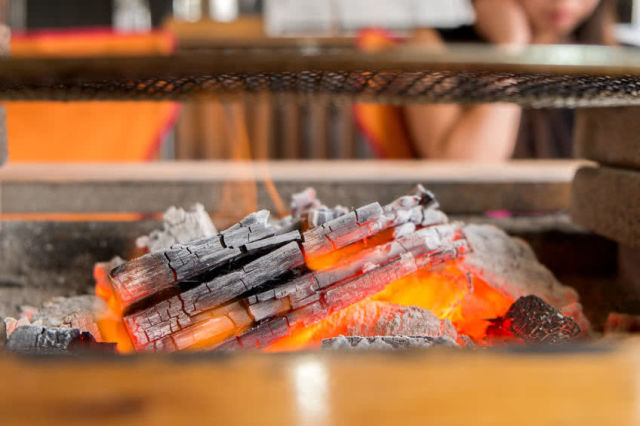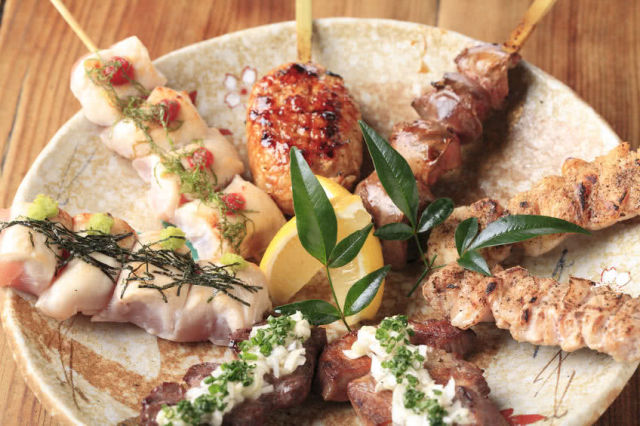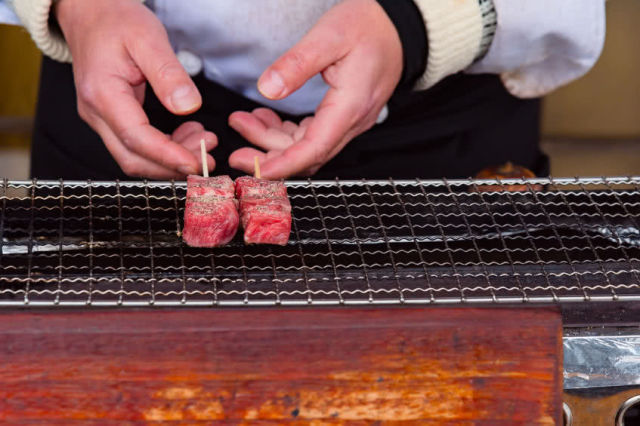>Translating literally to “fireside cooking,” robatayaki is a traditional style of coal grilling that originated in Hokkaido, the northernmost prefecture of Japan. It is a rustic style of cooking, where food is grilled over an irori, a sunken hearth that once featured in many Japanese houses. Due to the harsh winters of the Hokkaido region, robatayaki was both a way of cooking and of keeping warm. Robatayaki - or simply “robata” - restaurants these days typically feature a large irori hearth or grill around which chefs cook.
Standard robatayaki grilling fare includes skewered meat, vegetables, and seafood, all cooked at high temperatures over 1000 F (about 540 C), which helps preserve the natural flavors and juices of the food. Grilled food is then scooped up and delivered to customers on a long wooden paddle. The theatrical element of robatayaki, combined with the homey presentation and wide selection of custom-order ingredients make it a popular evening dining option in Japan.
A Guide to Robatayaki, Japan’s Authentic Theater Dining
Robata Restaurants
 In a robatayaki restaurant, atmosphere and presentation are just as important as the quality of the food. The bar seats are arranged in a horseshoe shape around an open kitchen so customers can see the ingredients and watch their meals being prepared. There are usually table seats and booths for larger groups, but the bar is best for those who want the complete experience. A true robatayaki chef only cooks with bincho, a compressed wood charcoal with no additives or chemicals. Real bincho become so hot that they never flame up during cooking, only glow; if you see flames and smoke, the chef is using a different type of charcoal.
In a robatayaki restaurant, atmosphere and presentation are just as important as the quality of the food. The bar seats are arranged in a horseshoe shape around an open kitchen so customers can see the ingredients and watch their meals being prepared. There are usually table seats and booths for larger groups, but the bar is best for those who want the complete experience. A true robatayaki chef only cooks with bincho, a compressed wood charcoal with no additives or chemicals. Real bincho become so hot that they never flame up during cooking, only glow; if you see flames and smoke, the chef is using a different type of charcoal.Ingredients
 Like many traditional forms of cooking in Japan, the menu items are at the chef’s discretion and often change to reflect the current season. Fortunately, options are varied and there is something for just about every type of diner and dietary restriction. Popular grilled vegetables include mushrooms, asparagus, onions and peppers. Popular meat includes chicken - particularly thigh cuts, as well as beef, and pork. Many different types of seafood are commonly feature on a robatayaki menu, including shellfish like oysters, scallops and clams, and whole-grilled fish like kinki (deep sea perch), grilled sanma (Pacific saury mackerel) in autumn, and ayu (sweetfish) in summer. Fish is often salted before grilling over coals, a cooking style known as “shioyaki”. For those who aren’t sure what to order, many restaurants offer an omakase course, a set menu designed by the head chef.
Like many traditional forms of cooking in Japan, the menu items are at the chef’s discretion and often change to reflect the current season. Fortunately, options are varied and there is something for just about every type of diner and dietary restriction. Popular grilled vegetables include mushrooms, asparagus, onions and peppers. Popular meat includes chicken - particularly thigh cuts, as well as beef, and pork. Many different types of seafood are commonly feature on a robatayaki menu, including shellfish like oysters, scallops and clams, and whole-grilled fish like kinki (deep sea perch), grilled sanma (Pacific saury mackerel) in autumn, and ayu (sweetfish) in summer. Fish is often salted before grilling over coals, a cooking style known as “shioyaki”. For those who aren’t sure what to order, many restaurants offer an omakase course, a set menu designed by the head chef.Condiments
 The beauty of robatayaki is how well the grilled meats and vegetables retain their natural flavors. Because of this, meats are never marinated before grilling, though some items may be lightly seasoned or served with a condiment on the side. When ordering certain items, the chef may ask if you want it flavored with shio (salt) or tare (a brown dipping sauce similar to teriyaki). Other common condiments include togarashi (chili pepper), wasabi, and yuzukosho (a green paste made from the yuzu citrus, salt, and chili). The yuzu citrus tastes somewhere in between a lemon and a lime, and pairs well with just about everything.
The beauty of robatayaki is how well the grilled meats and vegetables retain their natural flavors. Because of this, meats are never marinated before grilling, though some items may be lightly seasoned or served with a condiment on the side. When ordering certain items, the chef may ask if you want it flavored with shio (salt) or tare (a brown dipping sauce similar to teriyaki). Other common condiments include togarashi (chili pepper), wasabi, and yuzukosho (a green paste made from the yuzu citrus, salt, and chili). The yuzu citrus tastes somewhere in between a lemon and a lime, and pairs well with just about everything.Characteristics of Cooking Robatayaki
 There are numerous types of barbecue in Japan, each with its own distinct cooking methods. For robatayaki to be authentic, certain traditions must be observed. First and foremost, the chef must cook with bincho charcoal, and only after it has heated to around 1000 degrees. An experienced chef knows how and when to adjust the coals in order to make sure the heat is evenly spread. If the coals are too crowded, the fire won’t have air to breathe and the temperature will be too low. Additionally, some chefs like to create different heat zones by crowding or separating some of the coals, allowing for hotter or cooler zones for different types of meat. A robatayaki chef always keeps a close eye on the grill, knowing when to turn the skewers and maintain the coals.As for the skewers, they should always be placed two to three inches from the fire to ensure they get the proper balance of air and heat. Both meat and vegetables should be thinly sliced so they can cook quickly; smaller portions also gives customers a chance to savor as many different menu items as possible.
There are numerous types of barbecue in Japan, each with its own distinct cooking methods. For robatayaki to be authentic, certain traditions must be observed. First and foremost, the chef must cook with bincho charcoal, and only after it has heated to around 1000 degrees. An experienced chef knows how and when to adjust the coals in order to make sure the heat is evenly spread. If the coals are too crowded, the fire won’t have air to breathe and the temperature will be too low. Additionally, some chefs like to create different heat zones by crowding or separating some of the coals, allowing for hotter or cooler zones for different types of meat. A robatayaki chef always keeps a close eye on the grill, knowing when to turn the skewers and maintain the coals.As for the skewers, they should always be placed two to three inches from the fire to ensure they get the proper balance of air and heat. Both meat and vegetables should be thinly sliced so they can cook quickly; smaller portions also gives customers a chance to savor as many different menu items as possible. How To Order And Eat at a Robatayaki Restaurant

 While skewers can be ordered individually for those who know exactly what they want, the most convenient option is to order the omakase, or chef’s special set. Most restaurants automatically serve an otoshi (small appetizer) before the meal, though this is sometimes optional. Like barbecue all over the world, nothing washes down grilled meats quite like a cold glass of beer, which also makes the perfect accompaniment to watching a grill master at work. The meal typically ends with a small rice dish with meat or seafood on top.
While skewers can be ordered individually for those who know exactly what they want, the most convenient option is to order the omakase, or chef’s special set. Most restaurants automatically serve an otoshi (small appetizer) before the meal, though this is sometimes optional. Like barbecue all over the world, nothing washes down grilled meats quite like a cold glass of beer, which also makes the perfect accompaniment to watching a grill master at work. The meal typically ends with a small rice dish with meat or seafood on top.Try Robata Restaurants For An Authentic Japanese Dining Experience
Robatayaki has grown immensely in popularity and is now available in every region of Japan. For those looking for an authentic, homestyle Japanese dining experience, robatayaki has something to satisfy just about every palate. Browse Savor Japan for the best places to eat Robatayaki.Discover more restaurants by area
Tokyo Area Near Tokyo Kyoto and Osaka Area Hokkaido Area Northern Honshu (Tohoku) Central Honshu (Chubu) Western Honshu (Chugoku) Shikoku Kyushu Okinawa and Southeast Islands


